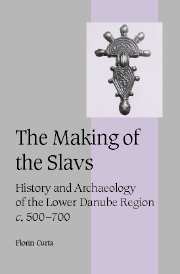Book contents
- Frontmatter
- Contents
- List of figures
- List of tables
- Acknowledgments
- List of abbreviations
- Introduction
- 1 Slavic ethnicity and the ethnie of the Slavs: concepts and approaches
- 2 Sources for the history of the early Slavs (c. 500–700)
- 3 The Slavs in early medieval sources (c. 500–700)
- 4 The Balkans and the Danube limes during the sixth and seventh centuries
- 5 Barbarians on the sixth-century Danube frontier: an archaeological survey
- 6 Elites and group identity north of the Danube frontier: the archaeological evidence
- 7 “Kings” and “democracy”: power in early Slavic society
- Conclusion: the making of the Slavs
- Appendix A
- Appendix B
- References
- Index
- Cambridge Studies in Medieval Life and Thought Fourth series
Conclusion: the making of the Slavs
Published online by Cambridge University Press: 08 July 2009
- Frontmatter
- Contents
- List of figures
- List of tables
- Acknowledgments
- List of abbreviations
- Introduction
- 1 Slavic ethnicity and the ethnie of the Slavs: concepts and approaches
- 2 Sources for the history of the early Slavs (c. 500–700)
- 3 The Slavs in early medieval sources (c. 500–700)
- 4 The Balkans and the Danube limes during the sixth and seventh centuries
- 5 Barbarians on the sixth-century Danube frontier: an archaeological survey
- 6 Elites and group identity north of the Danube frontier: the archaeological evidence
- 7 “Kings” and “democracy”: power in early Slavic society
- Conclusion: the making of the Slavs
- Appendix A
- Appendix B
- References
- Index
- Cambridge Studies in Medieval Life and Thought Fourth series
Summary
As its title suggests, the subject matter of this book is not the Slavs, but the process leading to what is now known as “the Slavs.” This process was a function of both ethnic formation and ethnic identification. In both cases, the “Slavs” were the object, not the subject. The preceding chapters have presented a series of perspectives on the history and archaeology of the Lower Danube area during the sixth and seventh centuries. Each approaced a different aspect of the process of constructing a Slavic ethnie and each highlighted specific themes and arguments. This chapter will review those themes, but will also attempt to string them all together into a tripartite conclusion. In doing so, it will focus on the major issues presented in the introduction: the migration and the making of the Slavs. Though in agreement with those who maintain that the history of the Slavs began in the sixth century, I argue that the Slavs were an invention of the sixth century. Inventing, however, presupposed both imagining or labeling by outsiders and self-identification.
MIGRATION
A brief examination of the historiography of the “Slavic problem” yields an important conclusion: the dominant discourse in Slavic studies, that of “expert” linguists and archaeologists, profoundly influenced the study of the early Slavs.
- Type
- Chapter
- Information
- The Making of the SlavsHistory and Archaeology of the Lower Danube Region, c.500–700, pp. 335 - 350Publisher: Cambridge University PressPrint publication year: 2001



